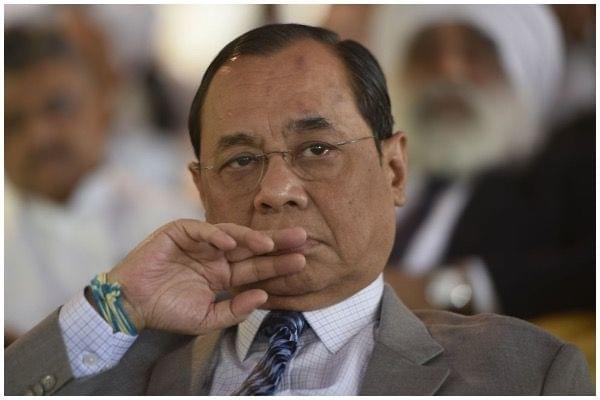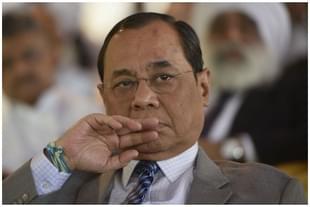Ideas
CJI Gogoi’s Diatribe Against Pressure From ‘Populist Forces’ Is Misdirected
R Jagannathan
Jun 19, 2019, 11:45 AM | Updated 11:45 AM IST
Save & read from anywhere!
Bookmark stories for easy access on any device or the Swarajya app.


The Chief Justice of India (CJI), Ranjan Gogoi, chose to air what seems like predominantly Indian concerns at a global forum, a gathering of chief justices and judges of the Shanghai Cooperation Organisation (SCO) in Sochi, Russia. Among other things, he observed that politicians criticise “unelected judges” for overturning the “acts of the elected majority”.
He is quoted by The Times of India as saying: “To some critics and naysayers, this situation presents a case for hoisting the classical counter-narrative – unelected judges, acting under the constitutional mandate, get to overturn the acts of the elected majority. However, it is for us to recollect that such situations across the world have heaped tremendous pressure on judicial organs, and it is no surprise that in some jurisdictions, judiciary too has succumbed to populist forces… This is also an area that requires the judiciary to prepare itself, to strengthen itself about such populist onslaughts on the independence of the institution.”
Given that no statement like this one is offered without context, one must assume that CJI Gogoi is – at least elliptically – talking about the situation in India, apart from the other parts of the world.
What one cannot be sure of is whether the above statement should be read as criticism or confession.
Let’s assume it is criticism first.
While it is true that some politicians have talked about an unelected judiciary overturning laws passed by elected legislatures, the argument in India is less about whether judges are elected or selected, but that they are self-selected. India’s is a unique judiciary, where a collegium of judges gets to appoint future judges. To repeat, the argument is not that judges are unelected, but that they have effectively and arbitrarily decided that they will select themselves.
Next, the question of the judiciary overturning laws passed by majorities should not be seen in the way CJI Gogoi chose to see it. In the case of the National Judicial Appointments Commission (NJAC), a law passed near unanimously by Parliament and a majority of state legislatures was overturned by a constitutional bench. But the real objection to what the judiciary did was not about it overturning a majority-passed law, but that it chose to be judge and jury in a case in which it is an interested party. One has to question the propriety of the judiciary striking down a law which not only had an overwhelming majority backing it, but also an unelected vested interest getting to decide the case. The NJAC, in any case, did not transfer the right to appoint judges to the executive; it gave both executive and judiciary equal powers to appoint or veto judges. It had struck a good balance.
Worse, in the Indian context, the judiciary not only gets to overturn laws, but also make the law. Article 142, which deals with the “Enforcement of decrees and orders of the Supreme Court…”, says this:
“(1) The Supreme Court, in the exercise of its jurisdiction may pass such decree or make such order as is necessary for doing complete justice in any cause or matter pending before it, and any decree so passed or orders so made shall be enforceable throughout the territory of India in such manner as may be prescribed by or under any law made by Parliament and, until provision in that behalf is so made, in such manner as the President may by order prescribe.”
In short, this article allows the Supreme Court of India almost the same power as the legislature, and at least in this case, the argument about unelected people making the law (or unmaking it) is a valid one.
Article 142 has been repeatedly used by the Supreme Court not just to overturn laws passed by elected majorities, but to supplant legislature-created laws with its own laws. Nowhere in the civilised world do courts enjoy the right to make law. Unelected judges can overturn laws made by the legislature, but can unelected judges make a law that ranks in the same league as laws passed by popular mandate?
Another contestable assertion of the CJI was his reference to populism, where he talks about “populist onslaughts on the independence of the judiciary”.
In India, one has seen no populist onslaught against the judiciary; in fact, one can argue the exact opposite: that the judiciary is itself occasionally pandering to populism by taking on cases like how cricket should be run (involving changes in how the Board of Control for Cricket in India should be administered) or how the Ganga should be cleaned, or whether SUVs entering Delhi should be taxed more because of pollution. Taxation, surely, was never intended to be a judicial right.
The Supreme Court has been happy to take up scores of public interest litigations (PILs), many filed by ideologues like Prashant Bhushan or others of his ilk. It appears as if the judiciary is sometimes keener to adopt this unconventional way of rendering justice than in the mainstream cases that come up before the court.
PILs have become so rampant, that in a judgement last year, Justice D Y Chandrachud came down harshly upon it: “It is travesty of justice for the resources of the legal system to be consumed by an avalanche of misdirected petitions purportedly filed in the public interest which, upon due scrutiny, are found to promote a personal, business or political agenda. This has spawned an industry of vested interests in litigation.” PILs, said Justice Chandrachud, had already “seriously denuded the efficacy of the judicial system by detracting from the ability of the court to devote its time and resources to cases which legitimately require attention.” (Italics mine).
In another case, the court fined one obsessive PIL-ster, who filed 64 PILs, Rs 25 lakh for wasting the time of the court with his deluge.
The question really is simple: why would there be a flood of PILs if the judiciary were really more selective about what kind of PILs it will entertain? It is this ambiguity, and possibly the idea that PILs tend to generate more publicity than regular cases, that may have been behind the judiciary’s willingness to consider so many PILs in the past. Maybe, this willingness is changing now, but as long as the PIL remains a shortcut to generating high media interest, it is difficult to reject the idea that PILs are a form of judicial populism or that the judiciary is reluctant to cut down on these cases.
CJI Gogoi’s observations at the SCO meeting of judges seems partly misdirected and a bit out of tune with Indian realities. A large part of the threat to the judiciary’s independence actually comes from within, from the roles the apex court has chosen for itself as against the roles that are legitimately its own.
Jagannathan is former Editorial Director, Swarajya. He tweets at @TheJaggi.




